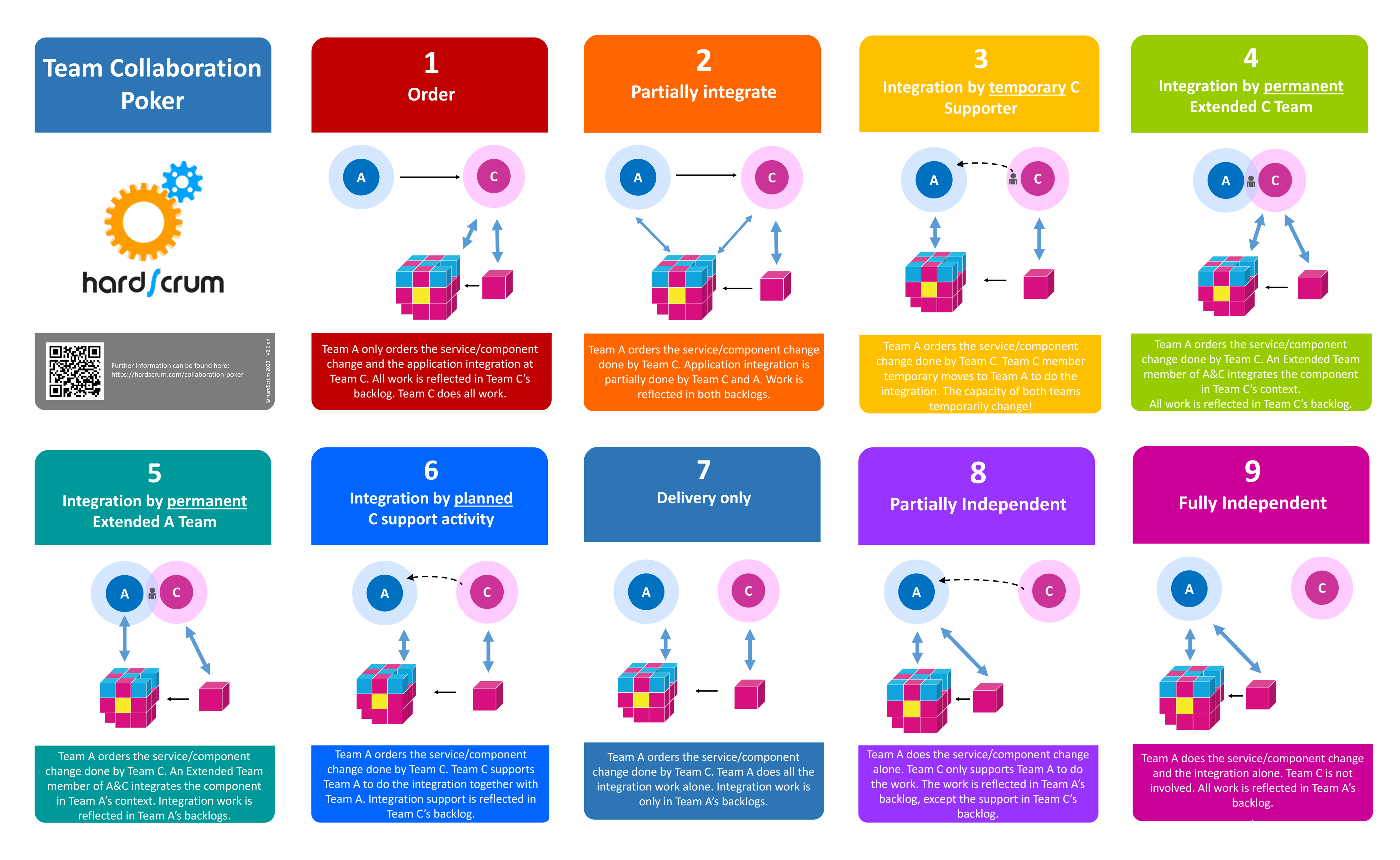Team Collaboration Poker is used for group-based discussion and negotiation of collaboration between two teams.
Collaboration between two teams can be very different and diverse. The card game is based on a typical situation of an application team and a service or component team, whereby the service or the component to be developed (or extended) is to be integrated into the application. When defining the collaboration, the focus is on which team takes on which tasks and responsibilities. The following options are available:
- Order: Team A only orders the service/component change and the application integration at Team C. All work is reflected in Team C’s backlog. Team C does all work.
- Partialy Integrate: Team A orders the service/component change done by Team C. Application integration is partially done by Team C and A. Work is reflected in both backlogs.
- Integration by temporary C Supporter: Team A orders the service/component change done by Team C. Team C member temporary moves to Team A to do the integration. The capacity of both teams temporarily change!
- Integration by permanent Extended C Team: Team A orders the service/component change done by Team C. An Extended Team member of A&C integrates the component in Team C’s context. All work is reflected in Team C’s backlog.
- Integration by permanent Extended A Team: Team A orders the service/component change done by Team C. An Extended Team member of A&C integrates the component in Team A’s context. Integration work is reflected in Team A’s backlogs.
- Integration by planned C support activity: Team A orders the service/component change done by Team C. Team C supports Team A to do the integration together with Team A. Integration support is reflected in Team C’s backlog.
- Delivery only: Team A orders the service/component change done by Team C. Team A does all the integration work alone. Integration work is only in Team A’s backlogs.
- Partially Independent: Team A does the service/component change alone. Team C only supports Team A to do the work. The work is reflected in Team A’s backlog, except the support in Team C’s backlog.
- Fully Independent: Team A does the service/component change and the integration alone. Team C is not involved. All work is reflected in Team A’s backlog.
But why “group-based”?
- It avoids one-sided views (swarm intelligence).
- It promotes structured discussions in groups.
- Everyone in the group gets a better understanding about the discussed topic.
The anchor phenomenum makes it difficult to get real, individual assessments in group-based discussions. The anchor problem means, that the assessments by all discussion participants are subconsciously biased to the assessment of the first one, who initially explains his/her opinion (anchor). To avoid this effect, everybody has to make his individual decision secretly before sharing it with the other group members. This is exactly what Team Collaboration Poker cards are for.
And how does it work?
Just follow these simple and clear steps to successfully play Delegation Poker. It is best to stick strictly to it at the beginning and only change things if you really understand the system.
Team A is responsible for an application or product to deliver. Team C is responsible for a service or component that then needs to be integrated into the application.
The game finds an agreed collaboration mode between the teams A and C.
- All players consisting of representatives of both teams have a card deck.
- They discuss about a service or change in the component, and how to integrate it into the application.
- Every player selects a card that corresponds to their opinion about the team collaboration.
- All cards selected are played at the same time
- The players discuss about their different opinions, especially outliers.
- The players repeat the steps 3 to 5 until the opinions converge.
Recommendation: Set a timebox for each estimation round (e.g. 10 minutes). When the time runs out, you can decide with the team to invest another 10 minutes or to continue.
Get your deck of Team Collaboration Poker cards at hardScrum.
Further suitable links:
| Events | Roles | Groups | Artifacts |
| Team Planning
. .
|
Team Product Owner
. . |
Working Team
. .
|
Team Backlog
. . |
